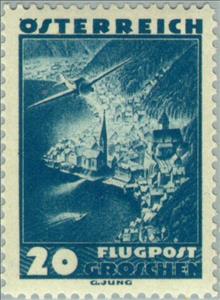Stamp: Aircraft over Hallstatt, Upper Austria (Austria 1935)
Aircraft over Hallstatt, Upper Austria (Austria 1935)
16 August (Austria ) within release Aircraft over landscape goes into circulation Stamp Aircraft over Hallstatt, Upper Austria face value 20 Austrian groschen
| Stamp Aircraft over Hallstatt, Upper Austria in catalogues | |
|---|---|
| Michel: | Mi:AT 601 |
| Yvert et Tellier: | Yt:AT PA35 |
Stamp is vertical format.
Also in the issue Aircraft over landscape:
- Stamp - Aircraft over Güssing Castle, Burgenland face value 5;
- Stamp - Aircraft over Maria-Wörth, Kärnten face value 10;
- Stamp - Aircraft over Dürnstein, Lower Austria face value 15;
- Stamp - Aircraft over Hallstatt, Upper Austria face value 20;
- Stamp - Aircraft over Salzburg face value 25;
- Stamp - Aircraft over Dachstein (Schladming Glacier) face value 30;
- Stamp - Aircraft over Wettersee in Otztal, Tyrol face value 40;
- Stamp - Aircraft over Stuben am Arlberg face value 50;
- Stamp - Aircraft over Vienna (Stephans Cathedral) face value 60;
- Stamp - Aircraft over Vienna (Minorites Church) face value 80;
- Stamp - Aircraft over Donau, Schönbühel Castle & Melk Abbey face value 1;
- Stamp - Aircraft over Tauernbahn Viaduct face value 2;
- Stamp - Aircraft over Grossglockner road face value 3;
- Stamp - Aircraft over Zugspitz Cable Track face value 5;
- Stamp - Aircraft over sailing boats on the Attersee face value 10;
- Stamp - Aircraft over Wettersee in Otztal, Tyrol face value 40;
Stamp Aircraft over Hallstatt, Upper Austria it reflects the thematic directions:
A landscape is the visible features of an area of land, its landforms and how they integrate with natural or man-made features. A landscape includes the physical elements of geophysically defined landforms such as (ice-capped) mountains, hills, water bodies such as rivers, lakes, ponds and the sea, living elements of land cover including indigenous vegetation, human elements including different forms of land use, buildings and structures, and transitory elements such as lighting and weather conditions. Combining both their physical origins and the cultural overlay of human presence, often created over millennia, landscapes reflect a living synthesis of people and place that is vital to local and national identity. The character of a landscape helps define the self-image of the people who inhabit it and a sense of place that differentiates one region from other regions. It is the dynamic backdrop to people’s lives. Landscape can be as varied as farmland, a landscape park, or wilderness. The earth has a vast range of landscapes, including the icy landscapes of polar regions, mountainous landscapes, vast arid desert landscapes, islands and coastal landscapes, densely forested or wooded landscapes including past boreal forests and tropical rainforests, and agricultural landscapes of temperate and tropical regions.
A tower is a tall structure, taller than it is wide, often by a significant factor. Towers are distinguished from masts by their lack of guy-wires and are therefore, along with tall buildings, self-supporting structures.
Aviation is the practical aspect or art of aeronautics, being the design, development, production, operation and use of aircraft, especially heavier than air aircraft. The word aviation was coined by French writer and former naval officer Gabriel La Landelle in 1863, from the verb avier (synonymous flying), itself derived from the Latin word avis ("bird") and the suffix -ation.
An aircraft is a machine that is able to fly by gaining support from the air. It counters the force of gravity by using either static lift or by using the dynamic lift of an airfoil, or in a few cases the downward thrust from jet engines. The human activity that surrounds aircraft is called aviation. Crewed aircraft are flown by an onboard pilot, but unmanned aerial vehicles may be remotely controlled or self-controlled by onboard computers. Aircraft may be classified by different criteria, such as lift type, aircraft propulsion, usage and others.




